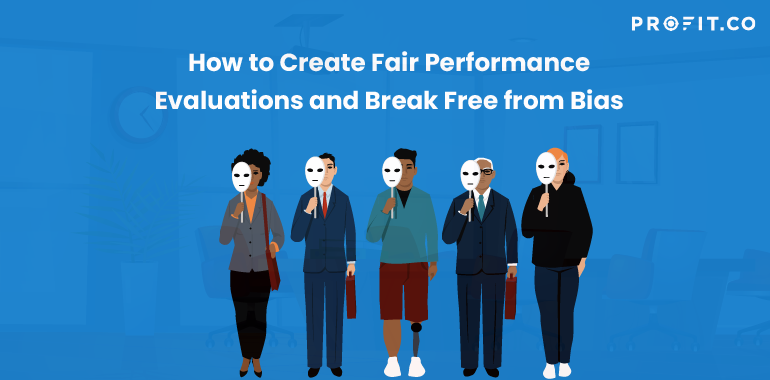Introduction
Performance evaluations greatly affect how employees are managed, developed, and promoted. They should be fair and based on measurable results. However, personal biases and opinions often creep into the process, causing unfair assessments. This can lead to frustration, inequality, and even roadblocks in an employee’s career.
What is Unconscious Bias?
Unconscious bias refers to our automatic judgments about others without even realizing it. These biases are often based on stereotypes or personal experiences and can influence decisions, including performance evaluations, without us being aware of it.
For example, someone might subconsciously think men are better at leadership roles, which could unfairly affect their evaluation of female employees. Even though we may believe we’re being fair, these hidden biases can still affect how we judge others.
“Stupidity and unconscious bias often work more damage than venality”
6 Common Types of Rater Bias
1. Affinity Bias
We tend to favor people similar to us, whether based on race, gender, background, or shared interests. This bias can lead to more positive evaluations for those we relate to, while others may receive harsher judgments.
2. Stereotyping
Stereotypes are preconceived notions about specific groups of people. These assumptions can influence how we evaluate someone’s performance. For instance, believing women are better suited for nurturing roles might affect how female employees are rated in leadership positions.
3. Halo and Horns Effect
The halo effect occurs when one positive attribute of an employee overshadows their other traits, leading to an overly favorable review. Conversely, the horns effect happens when one negative trait or incident unfairly influences the entire evaluation, resulting in an overly negative review.
4. Recency Bias
When we focus too much on recent performance, we may forget earlier achievements or challenges. Recency bias can lead to unfair evaluations that don’t reflect an employee’s overall performance throughout the evaluation period.
5. Confirmation Bias
This bias occurs when evaluators look for information that supports their preconceived opinions about an employee, often ignoring evidence that contradicts those beliefs. As a result, an employee may be judged based on earlier perceptions rather than their current performance.
6. Central Tendency Bias
Some evaluators may feel uncomfortable giving extreme ratings, preferring to keep most scores in the middle of the scale, regardless of actual performance. This central tendency bias results in employees being rated “average,” even when their work is exceptional or significantly underperforming.
Break free from bias in your performance reviews!
How Does Bias Affect Employee Development?
Biased evaluations can have wide-ranging consequences for both employees and organizations, including:
Limited Career Growth
Employees who receive biased evaluations might be overlooked for promotions, pay raises, or leadership opportunities, even if they perform well. This can stifle career progression and make it harder for talented employees to advance.
Workplace Inequality
Bias often leads to certain groups—such as women, minorities, or people with disabilities—receiving lower evaluations. This perpetuates inequality and results in less diversity at leadership levels, limiting the organization’s ability to foster innovation and inclusion.
Decreased Motivation and Engagement
Employees who feel unfairly evaluated may become demotivated, leading to disengagement from their work. This can reduce productivity and increase turnover in the long run as employees seek fairer opportunities elsewhere.
Lack of Development Opportunities
Biased evaluations often fail to provide meaningful feedback or development guidance, especially for those who receive unfairly low ratings. Without clear, constructive feedback, employees may not know how to improve or meet expectations, limiting their professional growth.
Inconsistent and Unfair Compensation
Since performance evaluations often directly impact compensation, biased reviews can result in unequal pay for employees in similar roles. This creates wage gaps and inequities, contributing to dissatisfaction and potential legal challenges.
Erosion of Trust in the Organization
Bias in performance evaluations can undermine trust in the fairness of the organization. Employees who feel they are judged unfairly may lose confidence in leadership, fostering a culture of distrust that can damage morale and collaboration.
Retention Challenges
Employees who consistently face biased evaluations may feel unvalued and may choose to leave the organization. This turnover can particularly damage retaining underrepresented or high-potential talent, making it harder for organizations to maintain a diverse and skilled workforce.
But how can organizations tackle this? Let’s look at some best practices to reduce bias.

Best Practices for Fair and Objective Performance Evaluations
Avoiding bias in performance appraisals is essential. Here are some of the best practices to ensure objectivity and consistency in your evaluations
1. Standardize Evaluation Criteria
One of the most effective ways to reduce bias is by establishing clear, objective criteria for performance evaluations. Instead of vague terms like “good communicator” or “team player,” set measurable expectations. For example, rather than saying someone is a “team player,” you could use specific criteria such as “attended and contributed to at least 90% of team meetings.” Clear expectations help limit personal interpretation, leading to fairer evaluations.
2. Train Managers to Recognize Unconscious Bias
Providing managers with unconscious bias training can significantly improve the fairness of evaluations. Biases often operate below the level of awareness, so training managers to identify and address their assumptions is critical. This training helps managers make more objective judgments, reducing the influence of personal preferences or prejudices.
Key benefits include
- Improved recruitment and retention
- Empowered employees who feel their unique perspectives are valued
- More innovation and creativity, as diverse teams often perform better
- More profitable and well-rounded organizations
3. Ensure Employees Know the Evaluation Criteria
Employees should be informed of their evaluation criteria from the start to avoid surprises. These criteria should be communicated during onboarding and reinforced throughout their time with the organization. Regular reminders during check-ins or team meetings help keep employees aligned with expectations and performance standards.
4. Implement Ongoing Feedback
Evaluating performance only at the end of the year can cause recency bias, where recent events are overemphasized. To counter this, conduct regular check-ins throughout the year. Continuous feedback allows managers to assess employee performance over time, providing a more complete picture rather than focusing on just the most recent accomplishments.
5. Use Well-Defined Rating Scales
Introducing clearly defined scoring systems can make evaluations more objective. For example, rather than using vague terms like “exceeds expectations,” create specific criteria such as “completed project ahead of schedule” or “met 90% of project milestones.” These measurable, transparent scales reduce ambiguity and ensure ratings are based on achievements, not subjective opinions.
6. Compare Employees’ Current Performance with Their Past Performance
Instead of comparing employees to their peers, which can foster bias, evaluating an individual’s growth over time is often more effective. This method highlights improvement and development, offering a fairer way to track progress. For example, rather than asking, “What have you done lately?” The focus should be on, “How have you grown or improved since your last evaluation?”
7. Use 360-degree Feedback for Multiple Perspectives
A 360-degree feedback system allows managers to collect performance feedback from multiple sources, including peers, subordinates, and supervisors. This method provides a more balanced view of an employee’s strengths and areas for improvement, minimizing bias that could result from relying on a single perspective. Employees also feel more engaged in the process, knowing feedback comes from various sources rather than one manager’s opinion.
8. Review Performance Evaluations for Consistency
Finally, reviews should be regularly assessed for inconsistency or potential bias patterns. Compare evaluations across different employees and timeframes to ensure fair application of standards. For instance, are certain groups consistently receiving lower scores? Spotting these discrepancies helps identify and address bias before it can cause long-term damage to your evaluation system
3 Ways AI Helps Minimize Performance Appraisal Biases
1. Data-Driven Insights
AI-powered tools can analyze large sets of performance data, from peer feedback to manager evaluations, and identify patterns that might indicate bias. By pulling data from multiple sources, AI gives managers a very accurate and objective view of an employee’s performance, reducing reliance on subjective judgments.
2. Automation of Evaluation Processes
AI can automate repetitive tasks like collecting and assessing performance metrics, reducing human error, and ensuring consistent employee evaluations. By standardizing the evaluation process, AI eliminates potential inconsistencies arising from personal biases.
3. Unbiased, Multi-source Feedback
AI-driven systems can gather and analyze feedback from multiple sources—peers, subordinates, and even clients—giving a balanced, 360-degree view of employee performance. AI can also filter out subjective or biased language from feedback, ensuring that the evaluation focuses on objective data rather than personal opinions.
While AI offers significant benefits, ensuring it operates ethically by addressing algorithm bias, maintaining transparency in decision-making, and maintaining human oversight to prevent the perpetuation of biases is essential.
How Institutions are Tackling Bias: A Look at the U.S. Government
Bias in performance evaluations is not just a challenge faced by the private sector; public institutions like the U.S. government also experience similar hurdles. With performance evaluations affecting promotions, compensation, and resource allocation, large institutions must address the biases that can impact their workforce.
Like many organizations, the U.S. government has recognized the need for change and has taken steps to reduce bias in performance evaluations. Government agencies are adopting various measures, including.
Unconscious Bias Training
Many U.S. government agencies are training managers and supervisors to recognize their biases. This training helps them understand how subconscious biases—such as racial, gender, or confirmation bias—might influence their assessments and equips them with strategies to mitigate those biases.
Data-Driven Evaluation Systems
Some agencies are moving towards using more standardized, data-driven evaluation processes. By focusing on clear, measurable performance metrics, these systems reduce the likelihood of subjective opinions affecting the outcome.
Multi-Source Feedback Systems
The U.S. government has also experimented with multi-source feedback to ensure more well-rounded evaluations. This system gathers input from peers, supervisors, and subordinates, providing a fuller picture of an employee’s performance and minimizing the influence of any single evaluator’s biases.
These proactive steps by the U.S. government are part of a larger effort seen across various industries to make performance evaluations more equitable. By implementing these changes, institutions are working to ensure that employees are assessed based on merit, which leads to fairer promotions, increased morale, and more effective team management.
Conclusion
Performance evaluations are essential for employee development, but bias can easily undermine their fairness and effectiveness.Incorporating advanced tools like AI-powered performance management systems can further help reduce bias. These systems offer data-driven insights, automate evaluation processes, and gather feedback from multiple sources, ensuring performance reviews are based on objective criteria rather than personal opinions.
An unbiased performance review process brings many benefits, from improved employee satisfaction to higher retention rates and more diverse, inclusive teams. Finding the right performance management partner can make all the difference, helping your organization track consistent data, set clear performance metrics, and ensure fairness across the board.
By prioritizing fairness in performance evaluations, organizations can foster a more inclusive, motivated, and high-performing workforce—one that feels valued and supported in their professional growth.
Ready to create fairer evaluations?
Related Articles
-
Can AI Think Like Humans? The Truth Behind AI Consciousness
Prakansha Charles Product Marketing Specialist Last updated: March 7, 2025 Artificial Intelligence (AI) has made remarkable strides in recent years,... Read more
-
5 Ways to Overcome Analysis Paralysis and Get Things Done
We’ve all been there. The mind starts swirling, the options start piling up, and before you know it, you’re staring... Read more
-
What is Democratic Leadership? A Complete Overview
Democratic leadership nurtures a positive work environment that motivates your team to perform better and succeed. Democratic leadership is successful... Read more
-
How Transactional Leadership Shapes High-Performance Teams
Transactional leadership empowers your team to perform better by instilling motivation through punishments and rewards. As a leader in any... Read more

